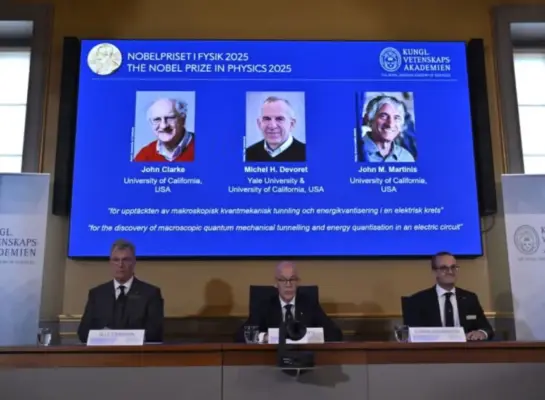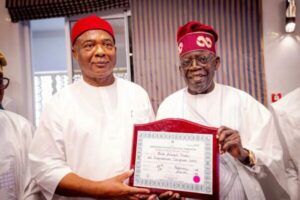The 2025 Nobel Prize in Physics has been awarded to US-based scientists John Clarke, Michel Devoret, and John Martinis for their pioneering work in quantum mechanical tunneling.
At a news conference on Tuesday in Stockholm, Sweden, the Royal Swedish Academy of Sciences stated that the prize was given for “the discovery of macroscopic quantum mechanical tunnelling and energy quantisation in an electric circuit.”
The academy explained that “this year’s Nobel Prize in Physics has provided opportunities for developing the next generation of quantum technology, including quantum cryptography, quantum computers, and quantum sensors.”
With a mission to promote the natural sciences, mathematics, and the exchange of ideas across disciplines, the academy disclosed that the 11 million Swedish kronor (£872,000) prize will be shared equally among the three laureates.
The body further noted that the Physics Nobel Prize winners conducted experiments with an electrical circuit, demonstrating both quantum mechanical tunnelling and quantised energy levels in a system large enough to be held in the hand.
“The laureates’ experiments demonstrated that quantum mechanical properties can be made concrete on a macroscopic scale,” it said.
It added, “In 1984 and 1985, John Clarke, Michel Devoret and John Martinis conducted a series of experiments with an electronic circuit built of superconductors, components that can conduct a current with no electrical resistance.”
Olle Eriksson, chairperson of the Nobel Committee for Physics, praised the laureates’ work and highlighted the enduring significance of quantum mechanics.
“It is wonderful to be able to celebrate the way that century-old quantum mechanics continually offers new surprises. It is also enormously useful, as quantum mechanics is the foundation of all digital technology,” Mr Eriksson said.
READ ALSO: Full List: Winners Of Nobel Prize In Medicine Since 1960
Below is a list of the winners of the Nobel Prize in Physics since 1990:
2025: John Clarke (Britain), Michel Devoret (France), and John Martinis (US), for the discovery of macroscopic quantum mechanical tunnelling.
2024: John Hopfield (US) and Geoffrey Hinton (Canada-Britain), for key breakthroughs in artificial intelligence.
2023: Pierre Agostini (France), Ferenc Krausz (Hungary-Austria), and Anne L’Huillier (France-Sweden), for research into tools for exploring electrons inside atoms and molecules.
2022: Alain Aspect (France), John Clauser (United States), and Anton Zeilinger (Austria), for groundbreaking work in the field of quantum mechanics.
2021: Syukuro Manabe (United States-Japan) and Klaus Hasselmann (Germany), for climate models, and Giorgio Parisi (Italy) for work on the theory of disordered materials and random processes.
2020: Roger Penrose (Britain), Reinhard Genzel (Germany), and Andrea Ghez (United States), for their research into black holes.
2019: James Peebles (Canada-United States), for discoveries explaining the evolution of the universe after the Big Bang, and Michel Mayor and Didier Queloz (Switzerland), for the first discovery of a planet outside the Solar System orbiting a star like our Sun in our home galaxy.
2018: Arthur Ashkin (United States), Gerard Mourou (France), and Donna Strickland (Canada), for inventions in the laser field used for advanced precision instruments in corrective eye surgery and industry.
2017: Barry Barish, Kip Thorne, and Rainer Weiss (United States), for the discovery of gravitational waves, a phenomenon predicted by Albert Einstein a century ago as part of his theory of general relativity.
2016: David Thouless, Duncan Haldane and Michael Kosterlitz (Britain), for their study of strange phenomena in unusual phases, or states, of matter, such as superconductors, superfluids, and thin magnetic films
2015: Takaaki Kajita and Arthur B. McDonald, “for the discovery of neutrino oscillations, which shows that neutrinos have mass”.
2014: Isamu Akasaki, Hiroshi Amano and Shuji Nakamura, “for the invention of efficient blue light-emitting diodes which has enabled bright and energy-saving white light sources”
2013: François Englert and Peter Higgs, “for the theoretical discovery of a mechanism that contributes to our understanding of the origin of mass of subatomic particles, and which recently was confirmed through the discovery of the predicted fundamental particle, by the ATLAS and CMS experiments at CERN’s Large Hadron Collider”.
2012: Serge Haroche and David J. Wineland, “for ground-breaking experimental methods that enable measuring and manipulation of individual quantum systems”
2011: Saul Perlmutter, Brian P. Schmidt and Adam G. Riess, “for the discovery of the accelerating expansion of the Universe through observations of distant supernovae”
2010: Andre Geim and Konstantin Novoselov, “for groundbreaking experiments regarding the two-dimensional material graphene”
2009: Charles K. Kao, “for groundbreaking achievements concerning the transmission of light in fibers for optical communication”
Willard S. Boyle and George E. Smith, “for the invention of an imaging semiconductor circuit – the CCD sensor”
2008: Yoichiro Nambu, “for the discovery of the mechanism of spontaneous broken symmetry in subatomic physics”
Makoto Kobayashi and Toshihide Maskawa, “for the discovery of the origin of the broken symmetry which predicts the existence of at least three families of quarks in nature”
2007: Albert Fert and Peter Grünberg, “for the discovery of Giant Magnetoresistance”
2006: John C. Mather and George F. Smoot, “for their discovery of the blackbody form and anisotropy of the cosmic microwave background radiation”
2005: Roy J. Glauber, “for his contribution to the quantum theory of optical coherence”
John L. Hall and Theodor W. Hänsch, “for their contributions to the development of laser-based precision spectroscopy, including the optical frequency comb technique”
2004: David J. Gross, H. David Politzer and Frank Wilczek, “for the discovery of asymptotic freedom in the theory of the strong interaction”
2003: Alexei Abrikosov, Vitaly L. Ginzburg and Anthony J. Leggett, “for pioneering contributions to the theory of superconductors and superfluids”
2002: Raymond Davis Jr. and Masatoshi Koshiba, “for pioneering contributions to astrophysics, in particular for the detection of cosmic neutrinos”
Riccardo Giacconi, “for pioneering contributions to astrophysics, which have led to the discovery of cosmic X-ray sources”
2001: Eric Cornell, Wolfgang Ketterle and Carl Wieman, “for the achievement of Bose-Einstein condensation in dilute gases of alkali atoms, and for early fundamental studies of the properties of the condensates”
2000: “for basic work on information and communication technology”
Zhores Alferov and Herbert Kroemer, “for developing semiconductor heterostructures used in high-speed- and opto-electronics”
Jack Kilby, “for his part in the invention of the integrated circuit”
1999: Gerardus ‘t Hooft and Martinus J.G. Veltman, “for elucidating the quantum structure of electroweak interactions in physics”
1998: Robert B. Laughlin, Horst L. Störmer and Daniel C. Tsui, “for their discovery of a new form of quantum fluid with fractionally charged excitations”
1997: Steven Chu, Claude Cohen-Tannoudji and William D. Phillips, “for development of methods to cool and trap atoms with laser light”
1996: David M. Lee, Douglas D. Osheroff and Robert C. Richardson, “for their discovery of superfluidity in helium-3”
1995: “for pioneering experimental contributions to lepton physics”
Martin L. Perl, “for the discovery of the tau lepton”
Frederick Reines, “for the detection of the neutrino”
1994: “for pioneering contributions to the development of neutron scattering techniques for studies of condensed matter”
Bertram N. Brockhouse, “for the development of neutron spectroscopy”
Clifford G. Shull, “for the development of the neutron diffraction technique”
1993: Russell A. Hulse and Joseph H. Taylor Jr., “for the discovery of a new type of pulsar, a discovery that has opened up new possibilities for the study of gravitation”
1992: Georges Charpak: “for his invention and development of particle detectors, in particular the multiwire proportional chamber”
1991: Pierre-Gilles de Gennes: “for discovering that methods developed for studying order phenomena in simple systems can be generalized to more complex forms of matter, in particular to liquid crystals and polymers”
1990: Jerome I. Friedman, Henry W. Kendall and Richard E. Taylor, “for their pioneering investigations concerning deep inelastic scattering of electrons on protons and bound neutrons, which have been of essential importance for the development of the quark model in particle physics”





